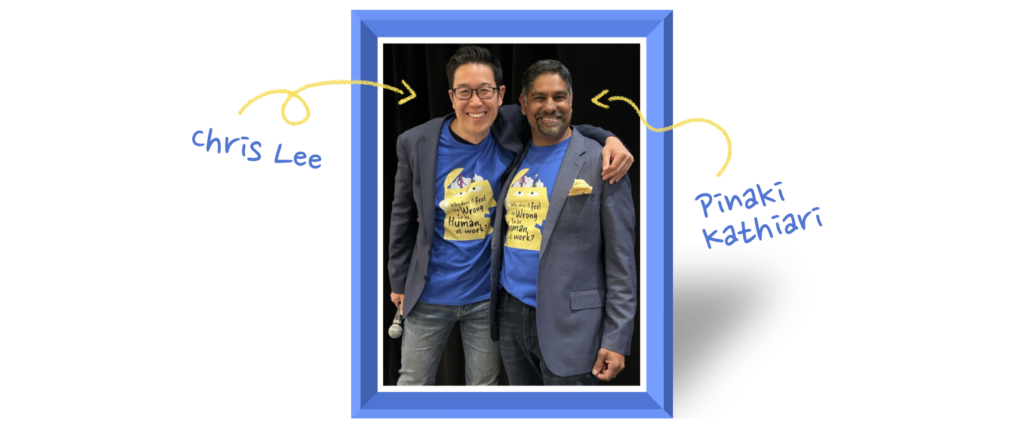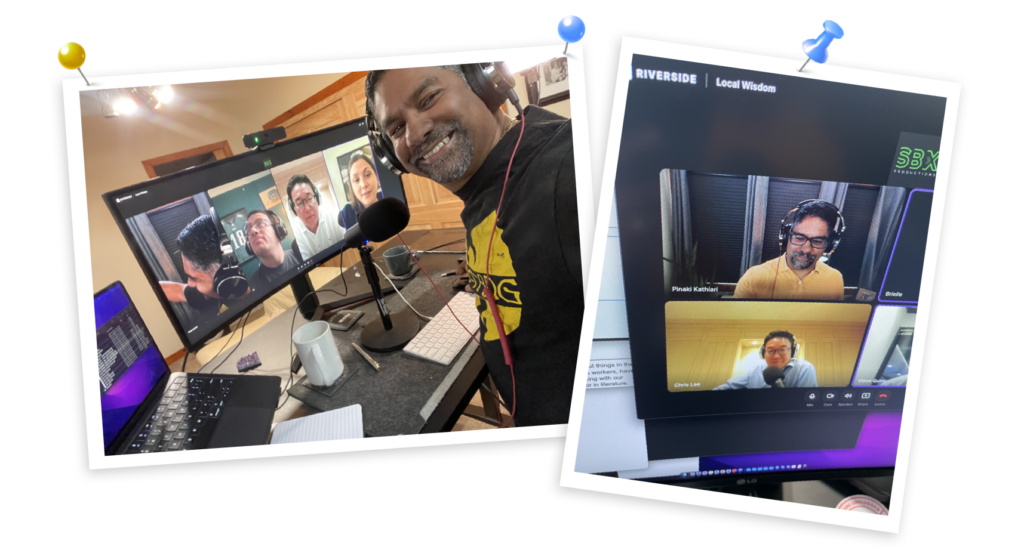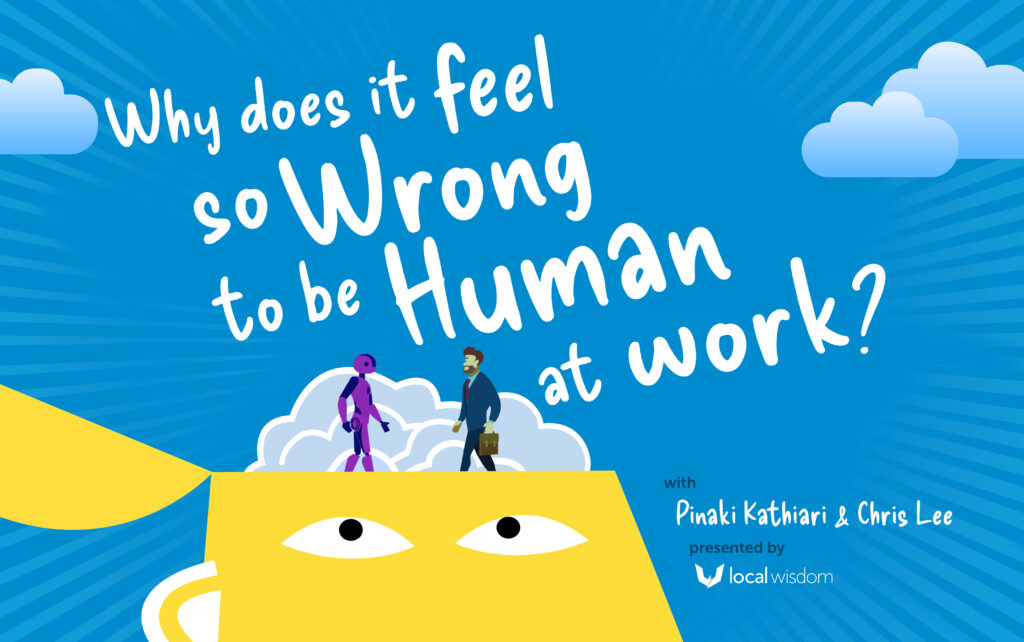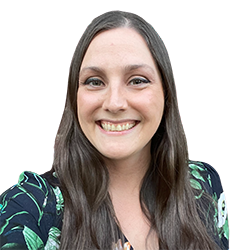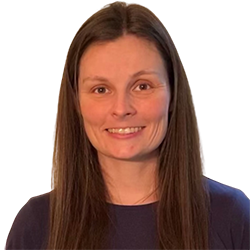8 Tips for When Your Homie Says, “Hey, Let’s Do a Podcast!”
Podcasts are all the rage. It’s estimated that there will be over 100 million podcast listeners in the US by 2024. Podcasts have been a form of mainstream media for a long time (thank you, Steve Jobs). From NYT’s “The Daily” to celebrity interviews on “Armchair Expert” and even paranormal activity in “Sasquatch Chronicles,” podcasts are a viable medium to get your messages, ideas, and wisdom to your audience. In fact, 78% of people listen to podcasts to learn new things.
If you’ve ever thought about starting a podcast for your business, whether it’s externally facing or within your employee base, then don’t touch that dial! In this blog post, Brielle Saracini, our podcast Producer and Local Wisdom Marketing Manager, and I will lift the curtain on our “Why Does It Feel So Wrong To Be Human At Work?” podcast and the process we took to get it off the ground and into the airwaves.
Wait… You have a podcast?!?!
Why, yes, we do! If you want a taste of where these tips came from, then check out our Local Wisdom-sponsored podcast wherever you listen to your favorite pods.
- Apple: https://apple.co/3MdUE2o
- Spotify: https://spoti.fi/3VTTzAi
- Simplecast: https://bit.ly/42kZscb
So, let’s dive into who we are and what our podcast is about.
Why Does It Feel So Wrong to – Huh?
Before we go any further, we should give you a quick summary of what our podcast is and what it is looking to accomplish. If you are already a loyal listener, feel free to skip below!
What we know: The world is constantly changing, and yet we’re still using outdated techniques in the workplace that are derived from an era long gone. Things are ripe for evolution. We don’t have all the answers, but we’re comfortable in asking the right questions and provoking the right thinking to get there. (Or at least to get closer.)
What we are doing: With this podcast, co-hosts Pinaki Kathiari and Chris Lee are challenging old practices with the goal of understanding what a better world looks like for employees, and by extension, society at large. We are looking at how we can inspire leadership, HR, and employees alike, to see that creating a human-centric approach will make a healthier environment for both the business and for the employee.
Why we are doing this: Because going to work shouldn’t make you anxious on Sunday evening. It shouldn’t be something so easy to parody. It should feel great. It should feel motivating. It might be naïve to think we can make this change, but companies spend so much to make the customer experience tremendous. They put so much effort into it. In the workplace, we should make just as concerted an effort to make each touch point for employees equally awesome. Not only do things sometimes feel robotic, but everything feels so transactional. It goes back to the fact that we are treated like result-makers, not humans.
How are we aiming to enact change: How we work has been a slow glacial movement. We get this opportunity to poke holes in what we see every day. That’s what “Why Does It Feel So Wrong To Be Human At Work?” is all about.
Brielle-Who?
As a producer on this project, I was thrilled by the fact that the “Why Does It Feel So Wrong To Be Human At Work?” podcast provides a genuine opportunity for authenticity and connection in the workplace. I felt that this podcast could actually make a positive impact by improving the norms of corporate culture. Plus, who doesn’t like to shake things up?
My role in this project came naturally to me as being a Producer was my full-time job before joining Local Wisdom. I spent a large part of my career working at the YES Network – the Regional Sports Network for the New York Yankees, Brooklyn Nets, and New York Liberty – in the Promotions and Features departments. So, when the opportunity to put that “Producer” helmet back on, the rest was just like riding a bike, except this time I was working in the podcast medium landscape!
Pina-What?
Truth be told, I’m not a big podcast listener. I have gotten fantastic tidbits of wisdom from listening to podcasts in the past, so I’m not knocking it. People have different ways they like to consume information, and I’ve become accustomed to audiobooks ever since the early-2000s.
So when Chris Lee, Vice President of Employee Experience & Communication at Gallagher, said, “Let’s do a podcast!” I was like, “I dunno about this…(?!?!)” As a CEO, thought leader, and public speaker, I’ve been a guest on podcasts and have no trouble being recorded, but this would be my first time doing an entire show.
Ten episodes later, with season one behind us, I’m sold. It’s been quite an educational journey. I not only learned new things, but I also learned about myself in the process and found myself becoming more human along the way.
Therefore, in the spirit of our Local Wisdom values of “learning from doing and sharing our wisdom” we decided to write this article to pay it forward. We are writing this to help others seeking podcasting advice, just as those who came before us and helped us navigate this podcast space.
So, without further ado, here are… 8 tips for when your homie says, “Hey, let’s do a podcast!”
1. Get Professional Help (Seriously)
Initially, Chris and I had planned to do this podcast on our own. The famous line spoken by many an executive came up, “How hard can it be?” As I looked at my workload and reflected on how I’m an audio snob who can’t listen to poor-quality audio, it became apparent quickly that we couldn’t do this alone. That’s when I brought in Brielle, and Brielle convinced me that we needed audio production help.
You need a producer who you can trust to let you know what’s working and what’s not. When you’re in it, it’s incredibly difficult to tell. I’ve had to lean on Brielle for emotional support. Brielle has heard me ask, “How did that sound?” and “Tell me honestly, do we suck?” a few times. However, it was incredibly helpful to hear her perspective.
Moreover, unless you are an egomaniac or a professional voice actor, you’re not going to like how you sound. That’s why you also need an audio engineer.

Employing an audio editor may seem like you’re cheating, but it really isn’t. Hire a podcasting company if you don’t have professional editors/podcasters/producers on your team. (Shout out to our incredible podcast partners, SBX Productions!) I can’t stress this enough – if the audio doesn’t have great sound quality, it won’t be successful because people won’t want to listen to it. Yes, even if the content itself is gold.
For recording, we have found that Riverside is a preferred (remote) recording platform. You can DIY on Riverside, and if you go with a professional company, you’ll find they likely use it as well. It’s great and has a video and audio component. There are tons of features, like how it records each track individually, so even if there’s talking over each other or Wi-Fi hits, it won’t ruin the recording. (No, they didn’t pay me to say this.)
Note: Regarding equipment, I am happy to share what our team used, but keep in mind that this was best for our space/location, etc., so it might vary based on your recording “studio” – as professional or DIY as that may be!
2. Choose a Concept That Makes You Excited and Nervous
A good piece entertains, educates, and evokes emotion. Think of something that will be interesting and informative for your audience but something that also has legs to expand to multiple seasons, guests, episodes, etc. Don’t make the topic too narrow and then run out of content quickly. Think of a concept that has a base level of natural evolution.
For example, our podcast is “Why Does It Feel So Wrong To Be Human At Work?” (WDIFSW), so that can be our premise for season one (and beyond). However, if we get to a place where we’d run out of topics (though, to be honest, I don’t think we will), then we can use this to expand the “Why Does It Feel Wrong To….” umbrella to other areas to keep the brand and podcast alive. Furthermore, be strategic about WHY you’re doing this. If you know your “why” and keep asking yourself that question, you’ll be more likely to stay on track and true to your mission.
The podcast concept came to me as a simple question I asked myself as I noticed a unique tendency with people at Local Wisdom spending time appreciating each other. (Tune in to episode 1 for a better and more detailed origin story.) The point is that the concept tickled my brain, and it kept coming up in my mind over and over again. It made me nervous because it was so profound, powerful, and something that everyone felt (but didn’t know it).
The excitement on Chris’ face (and everyone else I told) about the concept was a sure sign. The best way to know if someone “gets it” (by “it” I mean anything) is to have them say it back to you in their own words. Just by mentioning the name of the podcast, everyone instantly got it. After the initial eyebrow raise, they would immediately rattle off their own version, “… you mean like how…” – and from there, it was all systems go.
3. Create a Safe Collaborative Space
Start a shared document. When Chris and I started talking about this idea, and even before we had any structure, we started a shared Google doc. An idea can come up at any time and any place. We needed a way to jot down ideas on the go.
If you’ve ever spoken to Chris, you’ll know that amazing words of wisdom come out of his mouth often. Having a shared document was necessary to capture these nuggets from Chris and me as they later turned into podcast themes and content.
An obvious, yet essential factor is to have an honest conversation about the timeline and the time commitment this will take. I was fortunate to work with two hosts who were incredibly generous with their time and who really gave it their all. Not everyone is as lucky! A lot of people “want to start a podcast” but underestimate the amount of work that will need to go into it. Make sure you surround yourself with people who are as fully committed to the project as yourself.
4. Find Your Inspiration
Do some research! Listen to other podcasts in a similar space. Don’t steal anyone’s ideas, obviously, but inform yourself about what YOU think works well and use that as inspiration to add your own twist on things. Find what you like – and more importantly – what you don’t like about comparable shows.
To research, I talked to my trusted network of friends about it. First, to understand what they thought of the concept, but also to know what they listened to for work and personal, their listening habits, and their preferences for a podcast style.
As I mentioned before, I wasn’t a huge podcast listener, so I did my homework. I subscribed and listened to many podcasts from my favorite thought-leaders, shows people mentioned with various formats, and also some random ones. Listening to a wide array of pods helped me to know what I liked, what I didn’t like, how I’d do things differently for our podcast, and so on.
5. Structure, Don’t Script!
Have a rough outline complete with a catchy intro, some meaty (storytelling) segments, and a closing or “moral of the story” type of ending for each episode. Essentially, follow a typical narrative arc, even if you’re including branded recurring segments that may feel more like standalone segments.
Podcasts can appear to be largely unscripted, but that doesn’t excuse you from the planning side of things. Also, this may seem intuitive, but is definitely worth mentioning – don’t forget to have some fun with it and add in your personality! Before each recording, as a producer, I literally say, “REMEMBER: HAVE FUN!” to my co-hosts, and it breaks the ice a little bit, forcing a smile through any nerves.
Deciding on a structure was important for us to understand the flow, keep our podcast from going on for hours, and set a cadence for the dialogue. I find it’s better to create the structure and tweak it rather than start from scratch or simply freestyle.
Chris and I also brainstormed a list of about 40-50 episodes. We decided each episode would be a play off the title: “Why does it feel so wrong to __________ .” While we never scripted ourselves, we did structure our talking points.
And maybe a bit too much.
A few episodes in, I felt our podcast recordings weren’t as fluid and personable as the one-on-one conversations that Chris and I had leading up to the idea. Chris and I had some heartstring-pulling conversations about life and work… and somehow, it was getting lost.
We did two things to help us be organized but still natural. First, we kept the framework but started ditching the specific predetermined talking points (or just had talking points as short phrases so we could not read them while recording). Second, we also stopped sharing our talking points or ideas with each other ahead of our recording sessions. This kept us more on our toes and less reliant on notes, and we treated it more like a conversation as a result. (You’ll see this transformation around episodes 3-4.)
6. Keep it Short and Sweet
Our podcast is 35-40 minutes for each episode, but typically, I’d suggest striving for 20-30 minutes. Why? Based on conversations with several experts and knowledgeable consumers, this length is better for commutes and easy-digestible/manageable listening. I believe that 10 episodes per season is strong (typically ranging from 8-12/season). That said, keep in mind that there can be multiple “seasons” per year if you’re looking for more content.
Having a tight recording schedule helped to time-box ourselves. Being that the topic is vast, it’s easy to have a lot to say. Boiling the content down was a challenge, especially on episodes with topics I was extra passionate about (like the one about Belonging with Priya Bates and the one about saying “no” to your boss).
7. Make the Brand Stand Out
We needed to stand out in a sea of over 5 million podcasts worldwide.
With this tight schedule, our team at Local Wisdom (special shoutout to our incredible designer, Maggie Wang!) created the branding in less than two weeks. When conceiving the brand for the podcast, we took the time to understand our audiences, the podcasts they could be listening to, and how our graphics would sit among them.
We wanted to represent the concept of how work can be dehumanizing. We decided there would be no photos of Chris and me; it’s not about us. Instead, we chose to utilize illustration to represent the internal conflicts at play in all of us. With this current design era of straight, sans-serif typography, we wanted to stand out and create contrast with a more handwritten, “scripty” font with varied text sizing. This also helped us deal with our extremely long show title (that’s a whole other story for another time).
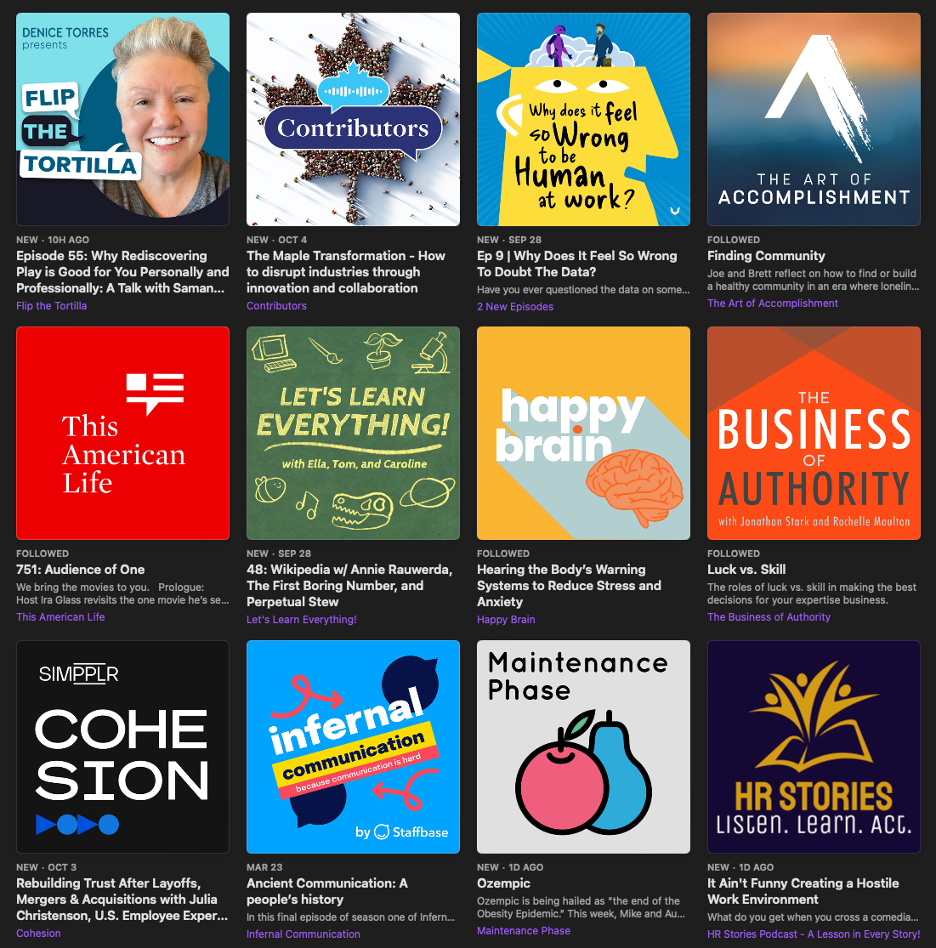
Think of something eye-catching and relevant to your audience. We went with a design that was a bit more abstract and compelling instead of just text and regular imagery. We knew the logo was going to be competing on podcast listening platforms, so we thought, “Would this make me stop scrolling?” and took it from there.
As far as the title goes, as mentioned above, we were advised that our title is way too long. The people who voiced this statement are definitely not wrong about that! We knew it, and we still did it. I don’t regret it because I think it really introduces the concept and primes your mind with a question that really makes you think; however, I would typically recommend that someone choose something shorter.
8. Tell the World
Promote, promote, promote… then review feedback and begin planning season two. We found LinkedIn and TikTok to be the best social media platforms for our podcast, but also tap into your supportive audience! We’ve found everyone to be so lovely and willing to help get the word out.
It’s a lot of work, and it can be draining. You just finished creating an episode, and then it’s about content for promotion. Thinking back, I’m glad we made the decision to record all episodes before launching the show. Balancing both episode creation and promotion at the same time would have been too much work at once, given our current workload. Videos work better on social. Share, reshare with comments, and tag people. Then run it back. Don’t stop sharing or bringing it up.
9. (Bonus) Determine What’s Next and Reflect on What This All Was For. Essentially: “Did we accomplish our mission?”
All communication serves a purpose, and your podcast should, too. Our purpose was to bring to light topics that seem antiquated but still persevere at work. In the weeks following a recording, I’d find myself tracking back to the episode as I go about my work. I’d think twice about replying to all, I’d censor my corporate buzzwords, and I’d feel more at ease with the feeling of needing a break.
Your podcast (or bits of it) should constantly replay in the minds of your listeners to change behavior. We know ours does based on the many anecdotal stories we’ve heard from our listeners as well as changes in ourselves.
Just having the list of season 1 episode titles in front of me helps me remain more human at work – even the titles themselves make you think. Here’s the list for you:
Why Does It Feel So Wrong To …
- Be Human At Work?
- Say “No” At Work?
- Take The Afternoon Off?
- Be Yourself At Work?
- Not Use Corporate Jargon?
- Reply-All?
- Create A Consumer-Grade Employee Experience?
- Put Yourself Before Your Company?
- Doubt The Data?
- Fail?
How can we help?
Are you thinking of starting your own podcast? Reach out here and let us know how we can assist in your creative process!





